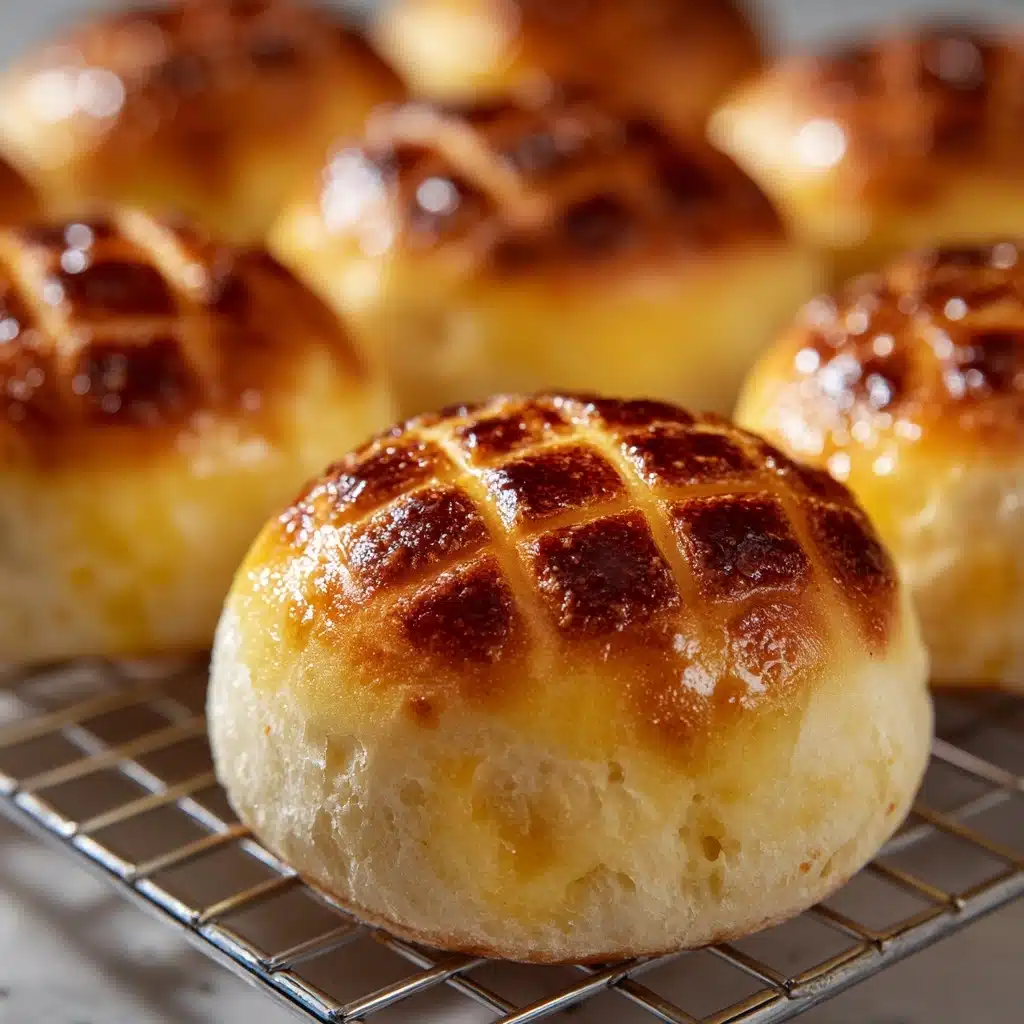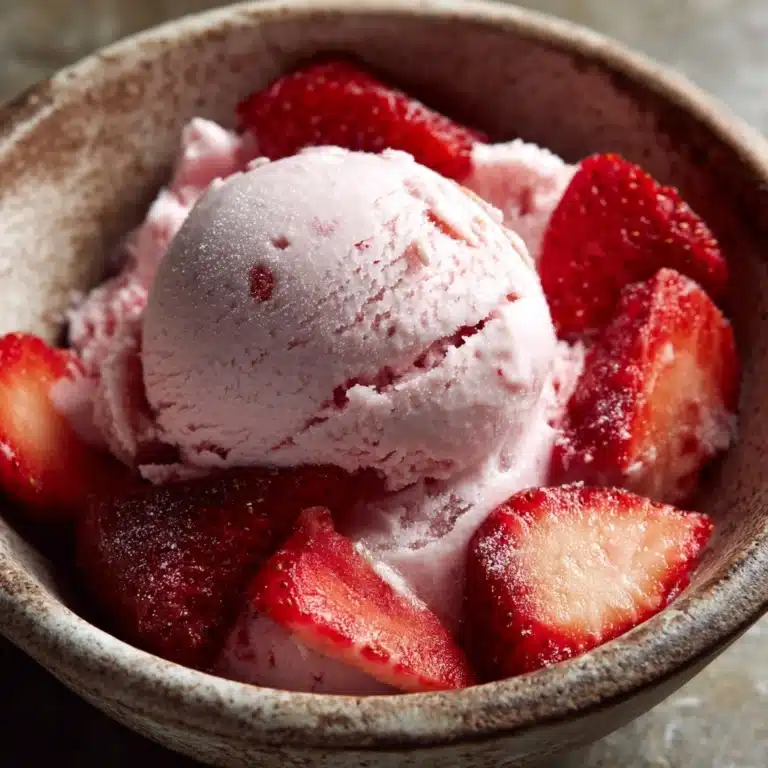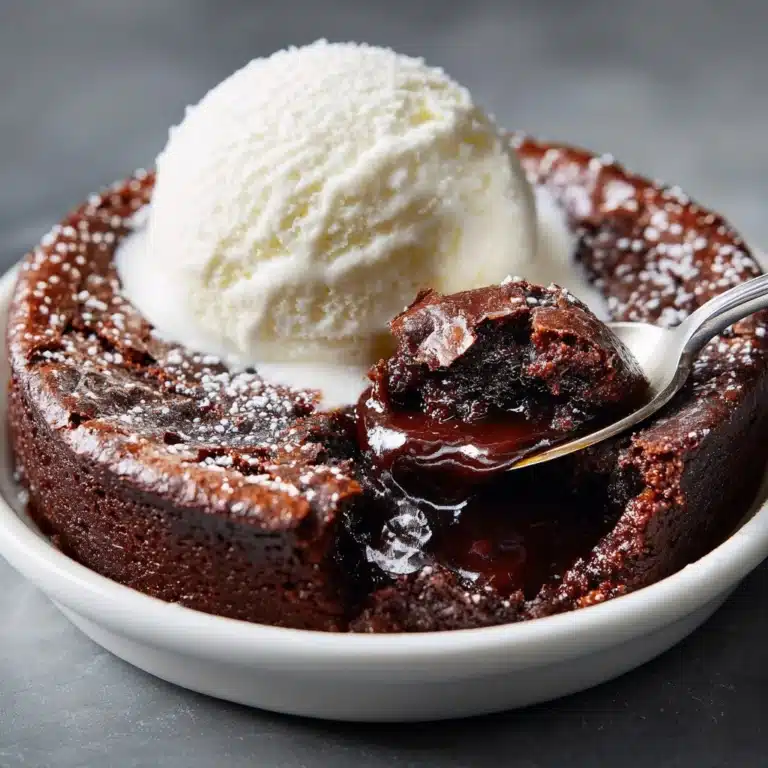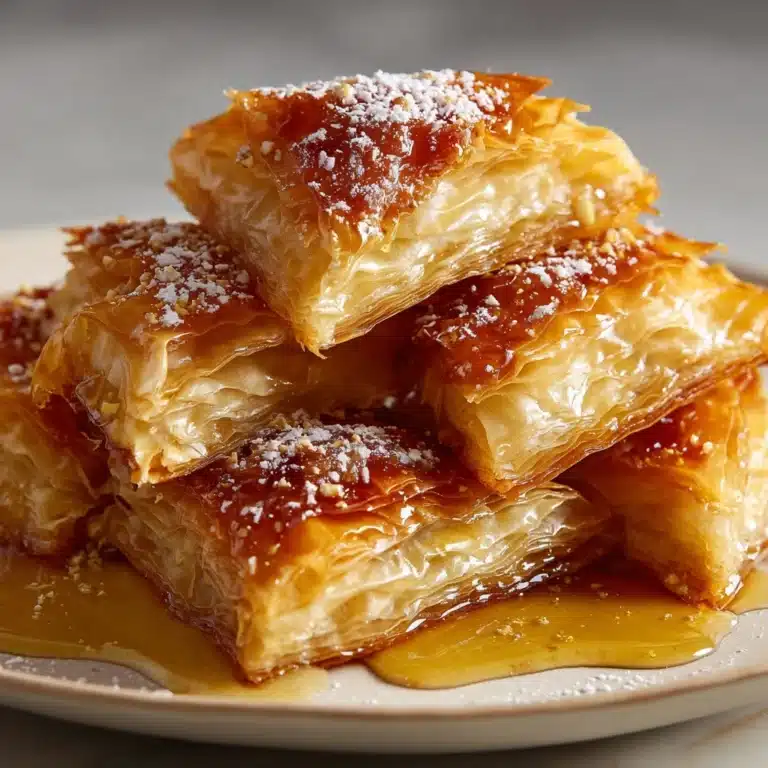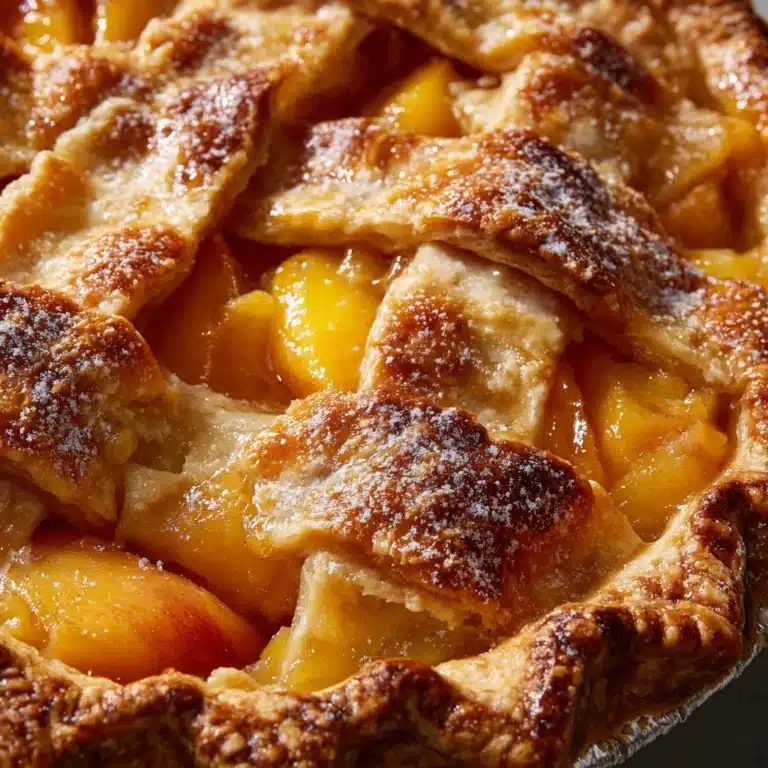If you’ve never tried Classic Japanese Melon Pan, you’re in for a treat that’s equal parts whimsy and comfort. Imagine soft, pillowy bread hugged by a golden, delicately crisp cookie crust—each bite transports you to a bustling Tokyo bakery. While its delightfully crisscrossed top resembles a melon, the flavor is a heavenly blend of sweet bread and rich cookie, making Classic Japanese Melon Pan a cherished snack for all ages. With a handful of pantry basics and a little patience, you can bring this beloved Japanese bakery staple right to your own kitchen!
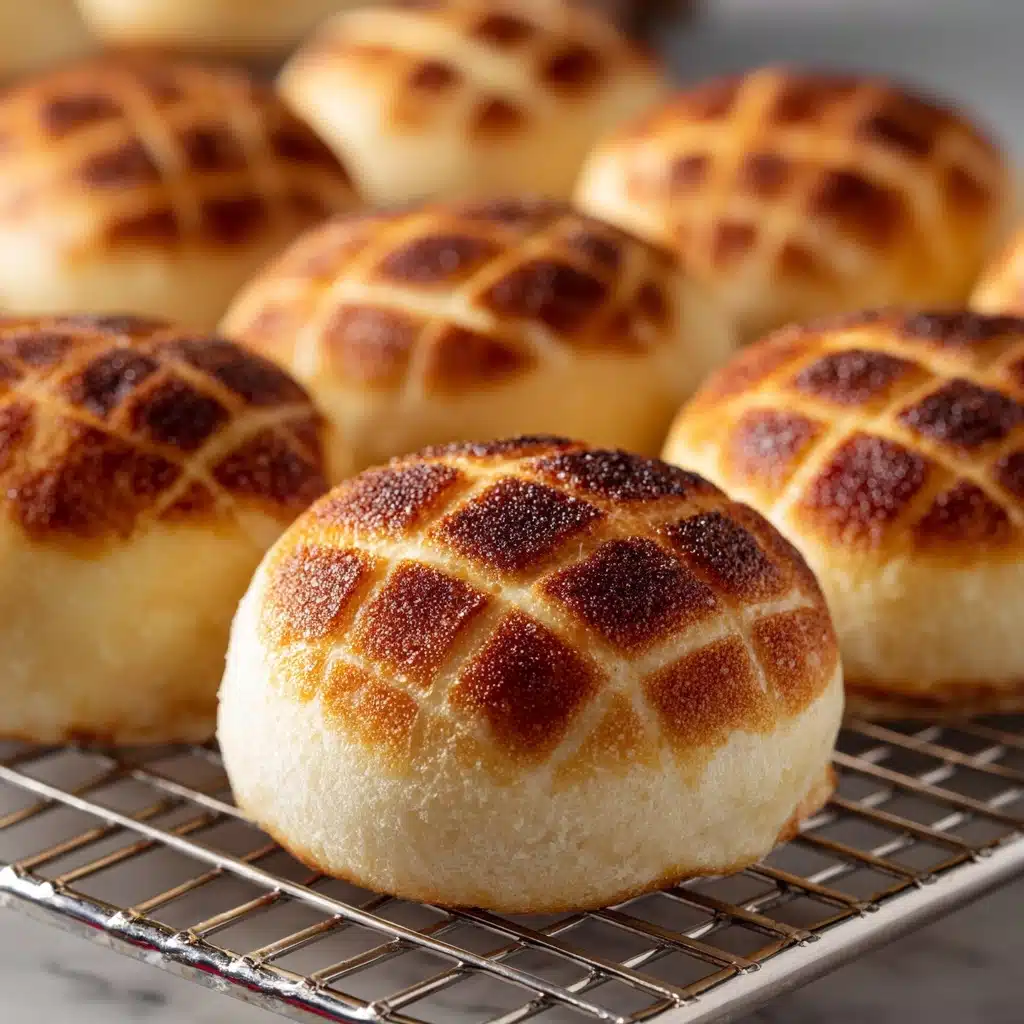
Ingredients You’ll Need
The magic of Classic Japanese Melon Pan starts with simple ingredients that come together for an extraordinary result. Each one plays a key role in creating the soft, airy bread and its sweet, crunchy topping.
- Bread flour: Gives the bread dough its signature soft-yet-chewy texture, perfect for supporting the cookie layer.
- Sugar: Essential for that touch of sweetness both in the bread and the cookie topping, ensuring every bite is as delicious as the last.
- Instant yeast: Lets the bread rise beautifully, making it light and fluffy inside.
- Salt: Just a bit brings balance and enhances the flavor of the dough.
- Warm milk: Adds richness, helps activate the yeast, and makes the bread wonderfully tender.
- Egg (plus extra yolk): An egg in the dough gives structure and softness, while an extra yolk in the cookie layer keeps it tender.
- Unsalted butter: Softened for easy blending; it gives both the bread and cookie topping their satisfying richness.
- All-purpose flour: Creates a tender, crumbly cookie crust—an unmistakable hallmark of Classic Japanese Melon Pan.
- Vanilla extract: Adds a fragrant aroma to the cookie layer. Don’t skip it!
- Milk (for cookie dough): Just a splash keeps the cookie topping pliable if it’s a bit dry.
- Granulated sugar (for dusting): A final sprinkle that gives sparkle and extra crunch when the pan comes out of the oven.
How to Make Classic Japanese Melon Pan
Step 1: Prepare the Bread Dough
Let’s get things started! In a large bowl, combine bread flour, sugar, instant yeast, and salt, giving everything a quick whisk to distribute evenly. Add the warm milk and the beaten egg, then stir until a shaggy, sticky dough forms—don’t worry, it’s supposed to be sticky at this stage! Now comes the fun (and arm workout): knead the dough for about 10 minutes. You’ll notice it becoming smoother and less sticky. Add the softened butter, and keep kneading for another 5 to 7 minutes until you get a silky, elastic dough. Shape it into a ball, pop it into a greased bowl, cover, and let it rise in a cozy spot until doubled in size. This will take about 60 to 90 minutes, giving you perfect bread for your Classic Japanese Melon Pan.
Step 2: Make the Cookie Topping
While the dough is working its magic, it’s time to craft that signature cookie crust. In a mixing bowl, cream together softened butter and sugar until the mixture is light and fluffy—this helps the cookie layer crisp up in the oven. Beat in the egg yolk and vanilla extract until smooth and fragrant. Stir in the flour and mix until a soft dough forms. If the dough feels crumbly, add a splash of milk to bring it together. Divide the cookie dough into 8 equal portions, roll each into a ball, and flatten into discs. Place them in the refrigerator to chill while your bread dough finishes rising.
Step 3: Shape and Assemble
After your bread dough has doubled in size, punch it down to release the air and divide it into 8 equal pieces (a kitchen scale makes this extra easy). Shape each piece into a smooth ball. Take a chilled disc of cookie dough and gently flatten it over each bread ball, letting it drape over the top and sides. The topping won’t cover the whole bottom—just concentrate on giving each bun a pretty cookie coat.
Step 4: Create the Signature Look
This is where Classic Japanese Melon Pan gets its “melon” nickname! With a sharp knife, score the cookie topping on each bun in a crosshatch pattern—think a checkerboard or the lines on a melon. Sprinkle the tops with a generous pinch of granulated sugar for extra sparkle and texture.
Step 5: Let the Buns Rest, Then Bake
Arrange your melon pan on a parchment-lined baking sheet, leaving some space for expansion. Let them rest for about 20 minutes to puff up slightly. Meanwhile, preheat your oven to 350°F (175°C). Once ready, bake for 15 to 18 minutes until the cookie topping is lightly golden and the bread is baked through. Cool on a wire rack before digging in—though I won’t judge if you sneak a warm one!
How to Serve Classic Japanese Melon Pan

Garnishes
While Classic Japanese Melon Pan is stunning on its own, you can add an extra touch by dusting with a bit more granulated sugar right before serving for sparkle and sweetness. If you want to get a little fancier, try a tiny drizzle of condensed milk or a sprinkle of edible gold dust—kids and adults alike will love the presentation!
Side Dishes
This sweet bread pairs beautifully with a warm cup of green tea or a café au lait for an afternoon treat. For breakfast, try serving Melon Pan alongside fresh fruit or a dollop of fruit preserves. The subtle sweetness and tender crumb make it the perfect match for just about any hot or cold beverage.
Creative Ways to Present
Classic Japanese Melon Pan can be split open and filled with lightly sweetened whipped cream or even a scoop of green tea ice cream for a lavish dessert sandwich! For parties, you can bake mini melon pan and serve them in cupcake liners for an adorable, grab-and-go option.
Make Ahead and Storage
Storing Leftovers
Melon pan are best enjoyed fresh, but if you do have leftovers, store them in an airtight container at room temperature for up to two days. The cookie crust will soften slightly, but a quick reheat restores some of the crunch and aroma. Avoid storing in the fridge as it will dry out the bread.
Freezing
If you want to enjoy Classic Japanese Melon Pan over the week, you’re in luck! Once completely cooled, wrap each bun tightly in plastic wrap and place in a freezer bag. Freeze for up to one month. Thaw at room temperature, then refresh in the oven for a few minutes to bring back their wonderful texture.
Reheating
To reheat, bake the melon pan at 300°F (150°C) for 5 to 7 minutes until warm and lightly crisp on the top. This helps bring back the signature crunch of the cookie crust and wakes up the delicate bread inside. For a softer bun, you can microwave for 10 to 20 seconds, but the cookie will be less crisp.
FAQs
What gives Classic Japanese Melon Pan its name?
Despite the name, melon pan doesn’t contain any melon flavor! The name comes from the crisscross pattern on the cookie crust, which resembles the look of a cantaloupe melon rind. The flavor is all about sweet, tender bread with a crisp cookie top.
Can I make Classic Japanese Melon Pan with all-purpose flour?
You can substitute all-purpose flour for bread flour in the dough, but the texture will be slightly less chewy and more cake-like. Bread flour really gives the best texture, but don’t let a lack of it stop you from enjoying this treat!
How do I get an extra crunchy cookie crust?
Chilling the cookie topping before shaping and making sure not to overbake are key! For an even crunchier top, you can roll the cookie discs in extra granulated sugar before laying them over the dough balls.
Can I flavor the cookie layer with matcha or cocoa?
Absolutely! Add 1 to 2 teaspoons of matcha powder or cocoa powder to the flour when preparing the cookie topping to infuse a fun new flavor and color. It’s a great way to customize Classic Japanese Melon Pan for holidays or parties.
Is Classic Japanese Melon Pan suitable for vegans?
With a few swaps—such as plant-based milk, vegan butter, and egg replacers—you can create a vegan version. The flavor will be slightly different, but the result is still absolutely delicious and true to the spirit of the original.
Final Thoughts
Baking Classic Japanese Melon Pan at home is truly a labor of love, but the sweet aroma filling your kitchen and the first bite into that crunchy, tender bun make every step worthwhile. Whether for breakfast, snack time, or dessert, I hope you’ll have as much joy sharing these with friends and family as I do. Don’t hesitate—dive in and try making Classic Japanese Melon Pan for yourself, and discover why it’s a beloved treat across Japan and beyond!
Print
Classic Japanese Melon Pan Recipe
- Total Time: 2 hours 15 minutes (includes rising time)
- Yield: 8 melon pan 1x
- Diet: Vegetarian
Description
Learn how to make Classic Japanese Melon Pan, a delightful sweet bread with a cookie crust. Despite its name, this treat doesn’t actually contain melon but gets its moniker from the melon-like appearance of its cookie topping.
Ingredients
For the Bread Dough:
- 2 cups bread flour
- 2 tablespoons sugar
- 1 teaspoon instant yeast
- 1/2 teaspoon salt
- 2/3 cup warm milk
- 1 egg, beaten
- 2 tablespoons unsalted butter, softened
For the Cookie Topping:
- 1 cup all-purpose flour
- 1/4 cup sugar
- 1/4 cup unsalted butter, softened
- 1 egg yolk
- 1/2 teaspoon vanilla extract
- 1 tablespoon milk (if needed)
- granulated sugar for dusting
Instructions
- Prepare Bread Dough: In a bowl, combine bread flour, sugar, yeast, and salt. Add warm milk and beaten egg, knead, then add butter and knead until smooth. Let rise.
- Make Cookie Topping: Cream butter and sugar, add egg yolk and vanilla. Mix in flour to form a dough. Divide into discs.
- Assemble and Bake: Divide risen bread dough, top each with a cookie disc, score, sprinkle with sugar. Bake until golden.
Notes
- Despite the name, melon pan doesn’t contain melon flavor—it’s named for the cookie top’s melon-like appearance.
- For a twist, add matcha powder or melon essence to the cookie dough.
- Best enjoyed the same day but can be refreshed in the oven.
- Prep Time: 25 minutes
- Cook Time: 18 minutes
- Category: Bread
- Method: Baking
- Cuisine: Japanese
Nutrition
- Serving Size: 1 melon pan
- Calories: 260
- Sugar: 10g
- Sodium: 140mg
- Fat: 8g
- Saturated Fat: 5g
- Unsaturated Fat: 3g
- Trans Fat: 0g
- Carbohydrates: 39g
- Fiber: 1g
- Protein: 6g
- Cholesterol: 50mg
